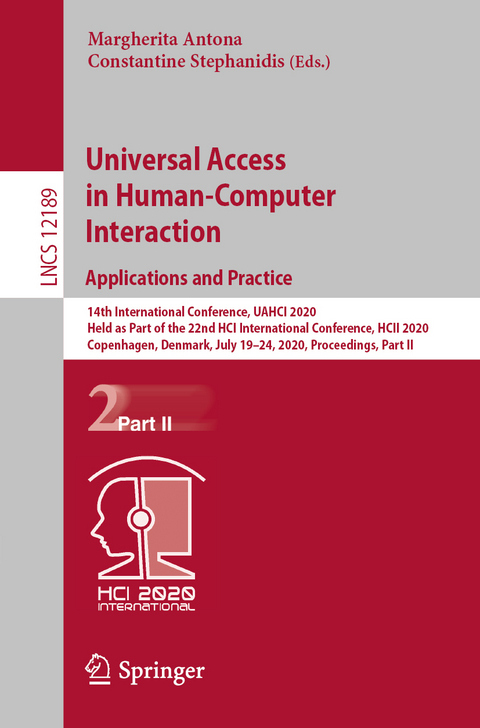
Universal Access in Human-Computer Interaction. Applications and Practice
Springer International Publishing (Verlag)
978-3-030-49107-9 (ISBN)
This two-volume set of LNCS 12188 and 12189 constitutes the refereed proceedings of the 14th International Conference on Universal Access in Human-Computer Interaction, UAHCI 2020, held as part of the 22nd International Conference, HCI International 2020, which took place in Copenhagen, Denmark, in July 2020. The conference was held virtually due to the COVID-19 pandemic. The total of 1439 papers and 238 posters have been accepted for publication in the HCII 2020 proceedings from a total of 6326 submissions.
UAHCI 2020 includes a total of 80 regular papers which are organized in topical sections named: Design for All Theory, Methods and Practice; User Interfaces and Interaction Techniques for Universal Access; Web Accessibility; Virtual and Augmented Reality for Universal Access; Robots in Universal Access; Technologies for Autism Spectrum Disorders; Technologies for Deaf Users; Universal Access to Learning and Education; Social Media, Digital Services, Inclusion and Innovation;Intelligent Assistive Environments.
Using Augmented Reality Technology with Serial Learning Framework to Develop a Serial Social Story Situation Board Game System for Children with Autism to Improve Social Situation Understanding and Social Reciprocity Skills.- Using Augmented Reality and Concept Mapping to Improve Ability to Master Social Relationships and Social Reciprocity for Children with Autism Spectrum Disorder.- Applying the Game mode and Teaching strategies of Computational Thinking to the Improvement of Social skills Training for Children with Autism Spectrum Disorders.- Process for a Technology Design Model Promoting Active Participation of End Users with Neurodevelopmental Disorders: Achievements and Pitfalls.- The STORM Project: Using Video Game to Promote Completion of Morning Routine for Children With Attention Deficit Hyperactivity Disorder and Autism Spectrum Disorder.- A Case Study about Usability, User Experience and Accessibility Problems of Deaf Users with Assistive Technologies.- ArSign: Toward a Mobile Based Arabic Sign Language Translator Using LMC.- Digital Accessibility in the Education of the Deaf in Greece.- Participatory Design Workshops for Adapting a Form for Deaf Respondents.- A Methodology for Assessing Translation Quality Generated by Sign Language Machine Translators: A Case Study with Vlibras.- Interest and Requirements for Sound-Awareness Technologies among Deaf and Hard-of-Hearing Users of Assistive Listening Devices.- Providing a Tangible and Visual Feedback of Affective States Self-Expressions.- Accessible Computer Science for K-12 Students with Hearing Impairments.- Competencies for Educators in delivering Digital Accessibility in Higher Education.- My A+ Math: Teaching Math to Students with Vision Impairment.- Video Games to Foster Empathy: A Critical Analysis of the Potential of Detroit: Become Human and The Walking Dead.- METUIGA "Methodology for the Design of Systems based on Tangible User Interfaces and Gamification Techniques" - Case Study: Teaching Geometry in Children with Visual Problems.- Makerspaces for Inclusive Education.- Situated Ability: A Case from Higher Education on Digital Learning Environments.- Digital Skills for People with Disabilities in a Learning and Demonstration Experience Laboratory - The project "Emscher-Lippe hoch 4".- Digitally-Supported Inclusive Vocational Education - Conceptual Considerations for the Hotel and Restaurant Industry.- Design of a Tangible Programming Tool for Students with Visual Impairments and Low Vision.- Accessible Learning Management Systems in Higher Education.- Open Government Data through the Lens of Universal Design.- Cultural Inclusion and Access to Technology: Bottom-up Perspectives on Copyright Law and Policy in Norway.- The Information Repertoire of People with Disabilities.- Startups.- I Can't Do It, They Say! - Perceived Stigmatization Experiences of People with Intellectual Disabilities when Using and Accessing the Internet.- Service Design for Accessible Tourism.- Homebased Telework as a Tool for Inclusion? A Literature Review of Telework, Disabilities and Work-Life Balance.- Travel Service Design for the Visually Impaired: User Experience from Combining Real Human Assistants and AI Devices in An Appropriate Proportion .- The Influence of Social Networking Technology on Centennials Purchase Intent.- Effects of Cognitive Consistency in Microtask Design with only Auditory Information.- Assistive Technology for the Visually Impaired: Optimizing Frame Rate (Freshness) to Improve the Performance of Real-time Objects Detection Application.- Affective Computing and Loneliness: How this Approach could Improve a Support System.- A Preliminary Investigation Towards the Application of Facial Expression Analysis to Enable an Emotion-Aware Car Interface.- Research on the Visually Impaired Individuals Shopping with Artificial Intelligence Image Recognition Assistance.- Single Image-Based Food Volume Estimation Using Monocular Depth-Prediction Networks.- On the Allocation of Resources in Sensor Clouds Under the Se-aaS Paradigm.- Applications of Speaker Identification for Universal Access.- Smartphone Navigation Support for Blind and Visually Impaired People - A Comprehensive Analysis of Potentials and Opportunities.- Designing System Architecture for the Catering Management System of Chang Gung Health and Culture Village.- E cient Small-Scale Network for Room Layout Estimation.- Low-Resolution Retinal Image Vessel Segmentation.
| Erscheinungsdatum | 29.06.2020 |
|---|---|
| Reihe/Serie | Information Systems and Applications, incl. Internet/Web, and HCI | Lecture Notes in Computer Science |
| Zusatzinfo | XXVI, 631 p. 203 illus., 172 illus. in color. |
| Verlagsort | Cham |
| Sprache | englisch |
| Maße | 155 x 235 mm |
| Gewicht | 997 g |
| Themenwelt | Mathematik / Informatik ► Informatik ► Betriebssysteme / Server |
| Informatik ► Software Entwicklung ► User Interfaces (HCI) | |
| Schlagworte | Applications • Artificial Intelligence • Computer Hardware • Computer Networks • Computer Science • Computer systems • computer vision • conference proceedings • Data communication systems • Disabilities • Education • Engineering • Human-Computer Interaction (HCI) • Image Processing • Informatics • Internet • learning • Network Protocols • Research • Signal Processing • Telecommunication networks • Telecommunication Systems • User Interfaces • user with disabilities |
| ISBN-10 | 3-030-49107-2 / 3030491072 |
| ISBN-13 | 978-3-030-49107-9 / 9783030491079 |
| Zustand | Neuware |
| Haben Sie eine Frage zum Produkt? |
aus dem Bereich


